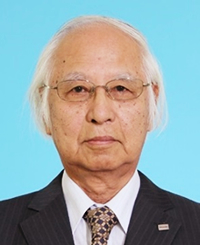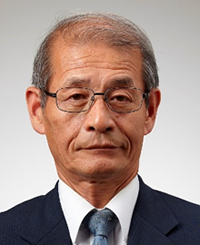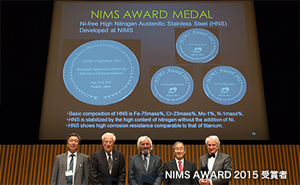NIMS Award 2016
This year, NIMS will honor achievements in the field of "environment & energy materials."
2016 Award Winners

Toshiba Research Consulting Corporation

Asahi Kasei Corp.
Research Achievment:
Koichi Mizushima proved that lithium cobaltite (LiCoO2) is an effective cathode material for secondary batteries. Akira Yoshino developed a prototype lithium-ion rechargeable battery using LiCoO2 as a cathode, carbon material as an anode, and propylene carbonate as an electrolyte. The development of the lithium-ion rechargeable battery contributed to the expansion of the markets of various mobile electronic devices, including cell phones, digital cameras, handy video recorders and laptop computers. Studies to develop higher-capacity, larger batteries are still ongoing through the development of materials and devices. The two researchers developed the lithium-ion battery through their material studies, producing an enormous impact on the industry and pioneering a new horizon in the field of battery research. Their achievements received high commendations in the environmental and energy materials field, which is the theme of NIMS Award 2016.
Winners Profile:
| Field of study | Environmental and energy materials |
|---|---|
| Title of research achievements | Discovery of a suitable cathode material for the lithium-ion battery (LiCoO2) |
| Outline of research achievements | The lithium (primary) battery with a metal lithium anode creates a high energy density. However, researchers in the 1970s had difficulty in developing a rechargeable battery because of durability and safety issues caused by dendrite formation during recharging. Most researchers saw sulfide materials as hopeful substances for the cathode but the voltage they create was insufficient for secondary batteries. In 1980, Mizushima and J.B. Goodenough (then Professor at Oxford University) discovered that the layered salt-rock oxide lithium cobaltite (LiCoO2) generates an electrical potential that exceeds 4V and that it can remove and provide lithium ions in a reversible manner in a wider range of compositions in comparison to metal lithium. They proved that lithium cobaltite (LiCoO2) can be used as a cathode for the batteries, enabling the use of an anode made of material that does not contain metal lithium. |
| Field of study | Environmental and energy materials |
|---|---|
| Title of research achievements | Development of the lithium-ion rechargeable battery |
| Outline of research achievements | Yoshino invented a prototype for the current lithium-ion rechargeable battery by adopting an innovative combination of cathode and anode materials (LiCoO2 as the cathode and polyacetylene as the anode) and by using propylene carbonate as an electrolyte. He subsequently discovered that the capacity density is significantly improved by replacing polyacetylene, which has low specific gravity, with vapor grown carbon fibers (VGCFs), and he made a great contribution to the commercialization of the lithium-ion battery. He also developed and invented various indispensable technologies for the practical application of the lithium-ion battery. For example, he invented a production method in which a sheet-like electrode with a current collector made of thin metal foil is wound like a coil after being coated with active materials on both sides. This invention made it possible to obtain a high current density even with a nonaqueous electrolyte, which is inferior in terms of electrical conductivity in comparison to aqueous electrolytes. His other inventions include the separator’s "fuse" function, which shutdowns the battery in the case of excessive heat by letting the separator filter between the cathode and anode melt down and close the microscopic pores itself. He also invented a positive temperature coefficient (PTC) device that controls the current with resistance increased by heat when the current is excessively high. The introduction of safety functions was essential for the practical application of the lithium-ion battery, which boasts high energy density. He made significant contributions to the development of such technologies as well. |
About the NIMS Award

Past Winners
2015Prof. Harald Rose (Ulm University, Germany)
Prof. Maximilian Haider (Karlsruhe Institute of Technology and CEOS, Germany)
Prof. Knut Wolf Urban (Juelich Research Centre, Germany)
2014
Prof. Krzysztof Matyjaszewski (Carnegie Mellon University, USA)
Prof. Mitsuo Sawamoto (Kyoto University, Japan)
2013
Prof. Hideo Hosono (Tokyo Institute of Technology, Japan)
2012
Prof. Harry K.D.H. Bhadeshia (Tata Steel Professor of Metallurg, University of Cambridge, USA)
Prof. John William Morris, Jr. (Department of Materials Science and Engineering, University of California, Berkeley, USA)
Prof. Subra Suresh (Director, National Science Foundation (NSF), USA)
2010
Prof. Jean Marie Tarascon (ALISTORE-ERI, Insitute of Chemistry of Picardie)
2009
Dr. Kazunori Kataoka (Professor, University of Tokyo, Graduate School of Engineering)
2008
Prof. Anthony G. Evans (University of California, Santa Barbara, USA) (1942-2009)
Prof. David R. Clarke (University of California, Santa Barbara, USA)
Prof. Carlos G. Levi (University of California, Santa Barbara, USA)
2007
Prof. William Butler (Director, Center for Materials for Information Technology (MINT), University of Alabama, USA)